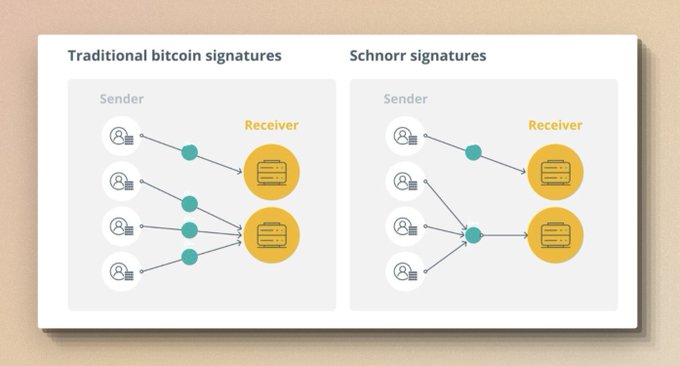Author: Chen Mo cmDeFi, Source: Author Twitter @cmdefi
Core idea: Using Bitcoin's economic security and Cosmos IBC cross-chain communication technology, BTC holders are allowed to provide an additional security layer for other PoS blockchains through a unique staking mechanism while maintaining asset autonomy and not leaving the Bitcoin network, and in exchange for benefits. Use certain advantages of proof of work (PoW) to provide security supplements to proof of stake (PoS).
"Remote staking" keeps the pledged BTC on the Bitcoin mainnet.
Creating a customized staking contract on Bitcoin, Babylon uses Bitcoin scripts and restrictions (covenants) to customize the operation of UTXO and create a special transaction type to complete the staking lock function.
Use the Cosmos IBC cross-chain communication protocol to seamlessly aggregate and transmit messages and data between Bitcoin and other blockchains.
Additional security layer. By recording the hash values of some key data of the PoS blockchain (such as transaction hashes, important decisions or status updates) to the Bitcoin blockchain, a "checkpoint" is established. Babylon can provide an unalterable timestamp proof for these data, which is equivalent to regularly anchoring a snapshot of the PoS chain state to the Bitcoin blockchain.
Research Report
Solution Analysis
As the second-highest asset in terms of market value, Ethereum has completed the first phase of its mission to become the largest smart contract platform. Now it is aiming to become a security layer for other networks and through the "Restaking" concept of EigenLayer.
In the PoS consensus mechanism, one of the main sources of security for the blockchain is to attract a large amount of capital through pledgeable assets and gradually establish economic security. The larger the network, the more ideal and consensus-strong assets are needed, and the more difficult it is to create such high-consensus assets. Currently, the only two assets with strong enough consensus are BTC and ETH. To solve this problem, projects like EigenLayer use the security of ETH to protect other blockchains or AVS, rather than bootstrapping it through high-cost token issuance.
So far, EigenLayer has been a huge success, having attracted more than $15 billion in TVL. As the only PoW chain with the strongest consensus, the strongest security, Bitcoin also has the potential to provide security services for other blockchains. At the same time, this will also provide a good PoW security supplement to the PoS consensus mechanism, and there is no need to argue whether PoW is better or PoS is better.
Babylon is committed to creating BTC staking, allowing BTC holders to share more than $1.3 trillion in economic security with other networks in exchange for staking income without leaving the Bitcoin network itself. In terms of the solution, Babylon achieves the recording and verification of key data submitted by the PoS chain through remote staking, customized staking contracts, timestamps, and EOTS (extractable one-time signatures). However, we need to be clear that Bitcoin's own architecture cannot verify complex operation logic and smart contracts, so there are still basic logical operations within the PoS chain. The Bitcoin PoW security provided by Babylon is an "extra security layer", which is a supplement to PoS security and can be said to have promoted the integration of PoS and PoW at the security level. At the same time, due to the different consensus mechanisms at the bottom level of Babylon and Eigenlayer, the two products differ in terms of service objects, protocol goals, etc. This point will be discussed after explaining the core principles of Babylon.
Babylon Architecture
Bitcoin Mainnet
Babylon Aggregation Layer
IBC Communication Protocol
PoS Consumption Chain (Target PoS Blockchain)
Babylon is essentially an aggregation layer used to build security between any PoS blockchain and Bitcoin. If a BTC holder wants to stake their assets, they can go to Babylon to select the qualified network they want to stake, and then lock their BTC on the BTC mainnet. The key data of PoS will be aggregated on the Babylon Chain aggregation layer and regularly sent to the Bitcoin network through IBC to establish "checkpoints". End users can claim the income of the target PoS network.
In this way, pledgers can continue to hold their BTC while earning additional income, while the PoS network inherits the economic security of Bitcoin at some cost.

![Image]()
Source: messari
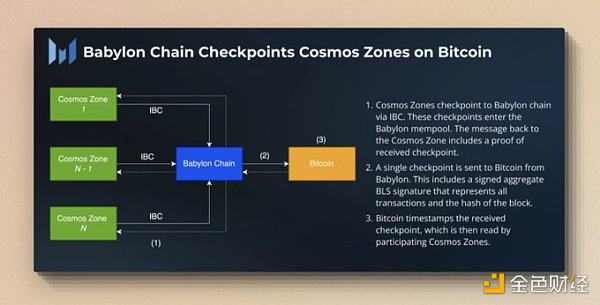
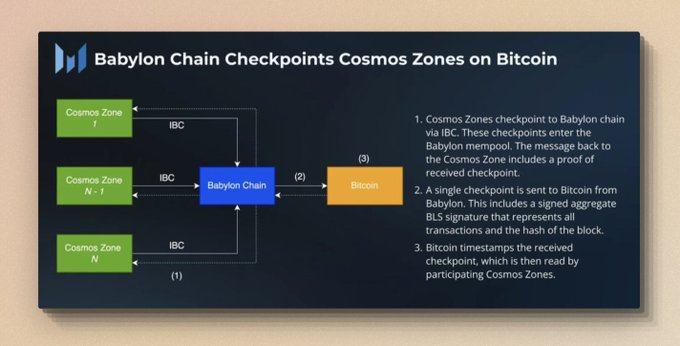
Remote Staking
Remote staking is a way for asset holders to earn income by providing staking verification services for other networks without moving their assets out of their native chain. The key to Remote Staking is to maintain autonomous control of assets and avoid doing so through third-party intermediaries such as custodial services or bridge services.
In the Babylon project, Bitcoin holders can stake their BTC on the Bitcoin network through Remote Staking, rather than through traditional transfers to other chains or centralized services. This is a "customized staking contract" implemented through improved Bitcoin scripts and specific transaction types.
Bitcoin Customized Staking Contract
Since Bitcoin does not support complex smart contracts, Babylon must implement the staking function within the scope of Bitcoin's existing scripting language. Unlike Ethereum, Bitcoin uses the UTXO (unspent transaction output) model, which means that each transaction output can become the input of another transaction.
Babylon customizes the operation of UTXO by using Bitcoin scripts and restrictions (covenants). Simply put, it is a tool to customize the behavior of Bitcoin transactions and create specific contract logic. It supports users to lock their Bitcoin for a period of time. Only after the lock-up period ends, users can use their private keys to redeem these assets. This "customized pledge contract" replaces the pledge contract implemented by smart contracts.
Submit data and verify
Data submission: Nodes on the PoS blockchain generate some important data and convert them into hashes, such as transaction or block information.
Send to the Bitcoin network: Babylon Chain is responsible for collecting these hashes and aggregating them. Through IBC, the packaged hash set will be submitted to the Bitcoin blockchain in a specific transaction.
Generate Timestamps: Once these hashes are recorded on the Bitcoin blockchain, they are given a timestamp from the Bitcoin blockchain. This generates a "checkpoint" that inherits the security of the Bitcoin network and is globally recognized and unchangeable. This means that anyone can view this Bitcoin transaction and confirm when this data was submitted based on the timestamp.
Use Timestamps: PoS blockchains can use these timestamps to verify the correctness and timeliness of their data. For example, they can reference these timestamps when processing transactions or verifying the authenticity of blocks.
The use of timestamps helps prevent some security issues such as replay attacks (in which old transactions are resubmitted to deceive the network) and long-range attacks (by creating an alternative chain that forks from an old state).
Security and Penalty Mechanism
Although Babylon has realized the basic staking function by customizing special UTXO operations, it is still far from smart contracts. For example, it is impossible to execute penalties through the logical operations of smart contracts, so Babylon has designed a penalty and reduction mechanism in its own way.
In the design of Babylon, two types of
signatures
are used to ensure the smooth operation of all mechanisms.
Schnorr signatures provide an efficient (aggregate) and secure way to process the signatures of Bitcoin pledgers.
EOTS is used to allow automatic extraction of private keys from signatures generated by malicious behavior and automated slashing when pledgers attempt to double-spend the network.
The Schnorr signature was introduced in Bitcoin's 2021 Taproot upgrade, mainly to address some limitations of traditional signatures in order to achieve a more efficient and concise signing method. The main feature is that it allows multiple signatures to be aggregated into one, which is very useful for multi-signature transactions and complex script transactions. At the same time, it can also significantly reduce transaction size and fees.
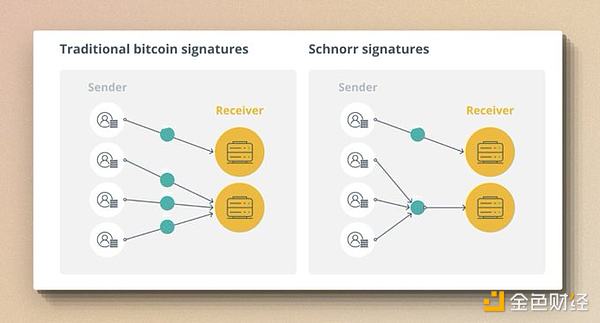
In terms of security, due to the limited expressive power of Bitcoin script, it cannot directly implement complex penalty mechanisms such as Slashing in PoS blockchains, so Babylon implements the Slashing mechanism through a clever design.
If a Bitcoin staker's private key is used to sign two different blocks at the same time, this behavior will be considered an attempt at a double-spending attack, and their private key will be made public. In this case, anyone can now pretend to be a staker and send a slashing transaction to the Bitcoin chain and burn the BTC that the staker is staking.
This is achieved through EOTS (Extractable One-Time Signatures), which are compatible with Schnorr signatures. This is a special form of encryption that ensures the integrity of block signatures and punishes improper behavior. The process involves an additional consensus layer, called the "finalization round," which comes into play after the basic consensus protocol functions on the consumer chain. A block reaches finality only after more than two-thirds of the EOTS signatures involving BTC stakes are collected. If any validator attempts to attack the protocol by signing two different blocks at the same block height, the EOTS system will ensure that their private keys are compromised.
The system also addresses the challenge of executing penalties on blockchains like Bitcoin that lack native support for smart contracts and complex transaction types.
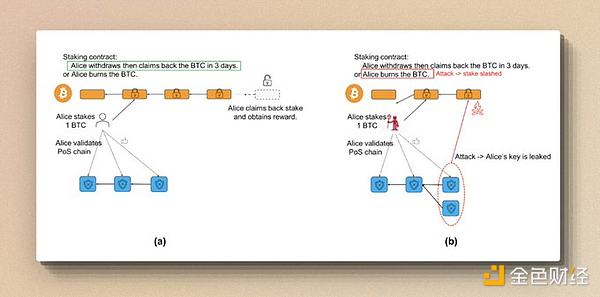
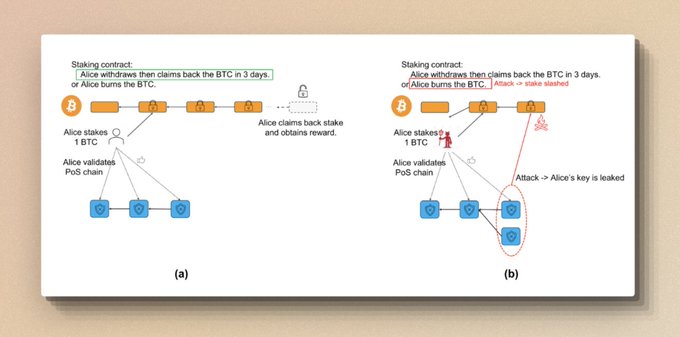
The Journey of a BTC Staker
The Journey of BTC Staker Alice:
(a) The Happy Path: Alice stakes, validates the PoS chain, requests unbonding, and is unstaked within 3 days.
(b) The Unlucky Path: Alice stakes, commits a security crime against the PoS chain, and then her BTC is burned.
Market Space
According to DefiLlama data, most of the current Bitcoin single-coin yields are between 0.01% and 1.5%, and the scale of those that can obtain a yield between 5% and 10% is very limited.
The market value of BTC currently reaches 1260B (1 BTC= $64000), the market value of WBTC is 10B, and the BTC that is currently actively earning income in DeFi is less than 5B, which is related to several aspects:
Most BTC holders are reluctant to let BTC leave the Bitcoin network
Concerns about the security of wrapped assets such as WBTC and tBTC
Too low returns
Part of BTC is dormant (according to
Coinshares
data, 25% of the BTC supply has been idle for more than 5 years, and 67% has been idle for more than 1 year)
A reference data, in 2021, Celsius attracted 43,000 BTC by offering a competitive 8% yield to BTC holders, currently worth nearly US$3 billion. It can be speculated that idle BTC holders have a need to earn income on their assets, but the main friction points are low returns, centralized trust assumptions and risks.
So assuming that Babylon's staking can capture nearly 8% of the income, then this may reach a scale of 3 billion US dollars. Combined with Babylon's decentralized nature and the fact that the staking of native BTC does not need to leave the Bitcoin network, it may have an impact on the tens of billions of market.

What problems are solved
According to the current project information, Babylon solves 4 problems:
Native staking of BTC on the Bitcoin network and providing higher income opportunities
Reduce the security budget of the PoS chain and reduce the emission of tokens to attract stakers
Provide a security supplement to PoW for the PoS chain - alleviate "long-range attacks"
Provide a security supplement to PoW for the PoS chain - increase the active attack threshold
Long-range attacks
First, let's understand what a "long-range attack" is. It is also called a long-distance attack (Long-Range A specific security risk faced by Proof-of-Stake (PoS) blockchains is a coin attack, which involves a staker using their staked tokens to create a fork at an earlier point in the blockchain's history after unbinding (i.e., getting their staked funds back). This attack attempts to rewrite the blockchain's history using past staked states.


Attack process1. Attack starting point: The attacker chooses an early point in the history of the blockchain, which is usually a time point when their stake is still valid. Then, they begin to secretly build a private fork chain at this point.
2. Build a forked chain: The attacker builds blocks on their own forked chain, which may include invalid or fraudulent transactions. Since they have sufficient stake rights at this historical time point, they can influence which blocks are added to this forked chain. 3. Release the fork: Once the fork chain is long enough to cover the same period of blocks on the main chain, the attacker can release it. Since the PoS protocol usually accepts the heaviest (i.e., the chain with the most accumulated staked rights or the longest chain) as the valid chain, the attacker's fork may be accepted by the network as the orthodox history. In the PoS system, since there is no need to perform a lot of calculations like PoW, it is relatively easy to reorganize old blocks (i.e., blockchain reorganization). The attacker only needs to show a chain on the private chain that is longer than the main chain or has more "weight" in some systems, and it may convince the network to accept its chain as the valid chain. This attack usually involves emerging or smaller PoS chains with fewer network nodes and weaker monitoring and security measures, because such networks are more susceptible to the influence of a few large stakers.
In order to mitigate long-range attacks, general PoS chains will set a minimum unbinding period, usually 7 days, 14 days, 21 days, which is why when you redeem assets (such as ATOM) from a node, you have to wait for a fixed period to get the staked assets. Setting an unbinding period means that once the validator decides to unbind their funds, these funds will not be immediately available. During this period, their stakes are still considered part of the network security, but they cannot use these stakes to verify new blocks or participate in consensus decisions, which greatly increases the cost and complexity of launching attacks.
How does Babylon mitigate "long-range attacks"?
Babylon aggregates the "unbinding" operation of the PoS chain by marking timestamps and setting checkpoints on the Bitcoin blockchain. The benefit of this is that it uses Bitcoin's strong consensus characteristics to provide an external security verification point for the PoS chain, which makes it possible to significantly reduce the time required for unbinding, from weeks to hours, which can significantly improve the liquidity and efficiency of funds.
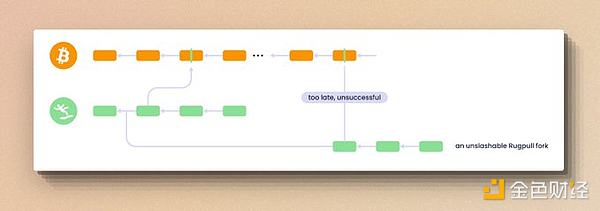
Activity Attack
Secondly, let's understand what an activity attack is. It refers to a situation where a small number of validators (such as one-third) may attempt to censor or block certain transactions or operations, thereby affecting the normal operation of the chain. For example, a validator deliberately does not include certain transactions, which may be for its own benefit or external incentives.
How does Babylon increase the threshold of active attacks?
Babylon uses the security of the Bitcoin blockchain to create checkpoints. These checkpoints are snapshots of the state of the PoS chain, anchored to the Bitcoin blockchain at regular intervals. This approach enhances the security of the PoS chain through the immutability of the Bitcoin blockchain, providing a trusted, externally verified record of important decisions or states on the PoS chain.
In addition, Babylon increases the economic and technical costs of attackers to carry out active attacks on PoS by creating an additional security layer on the Bitcoin blockchain. (This may include undermining Bitcoin's strong consensus)
Comprehensive analysis compared with Eigenlayer
Limitations: No smart contracts can achieve more advanced security support
The industry often compares Babylon with Eigenlayer. Eigenlayer coordinates the needs between AVS and Restaker re-stakers by writing smart contracts. In theory, as long as smart contracts can be written, Eigenlayer can be competent for the task, such as supporting the dual staking requirements of ETH Restaking and protocol token Staking, and setting adjustable ratio parameters, providing an additional layer of Ethereum-level security protection for existing middleware, and directly building the consensus layer of new middleware. Although smart contract risks are also introduced, it can support a wider range of businesses.
Babylon currently mainly implements the establishment of "checkpoints" by regularly taking snapshots of the state of the PoS chain on the Bitcoin chain, thereby providing a trusted, externally verified record based on strong consensus for the protected PoS chain. Although it implements BTC's native staking lock through customized UTXO, it still does not have smart contract-level functions and cannot handle and coordinate complex requirements and logic.
Limitations: Limited by IBC
Babylon uses IBC to aggregate data and communicate between Bitcoin and any PoS blockchain. This is a necessary prerequisite for BTC staking and setting checkpoints through timestamps. The reason for using IBC is that it has the ability to seamlessly transmit arbitrary data and validator messages between different chains. Currently, Babylon's current addressable market is 91 Cosmos chains that natively support IBC. However, extension protocols based on IBC are gradually being built, such as Composable, which is building IBC support for other networks such as Ethereum, Polkadot, Solana, NEAR, and TRON.
Advantages: The market space for idle BTC is huge
Compared to Eigenlayer, Babylon targets the underlying asset BTC. According to the discussion in the [Market Space] section, the current amount of idle BTC is very huge, and the basic demand of not leaving the Bitcoin main chain has been realized. In theory, once more partners access Babylon and provide considerable returns for BTC staking, the market will grow very rapidly.
Similarities: Support for economic security
The similarity with Eigenlayer is that Babylon also provides economic security support for some early small-scale PoS chains, increasing the economic and technical costs of attackers attacking small-scale PoS chains.
Differences: Service objects and goals
Babylon may be more effective in mitigating long-range attacks and shortening the lock-up period of PoS asset staking. For example, if Osmosis cooperates with Babylon, it may only take 1 day or even less (14 days) to release the pledged OSMO, which is a relatively clear demand. Of course, Babylon brings BTC's PoW strong consensus to PoS, and as the protocol matures, it may unlock more possibilities.
Eigenlayer relies on Ethereum's huge ecosystem, and through smart contracts + re-staking, it radiates Ethereum's security to every corner and middleware. Therefore, Eigenlayer fully obtains the inherent advantages of smart contracts in scalability, and is more diversified in service objects and function realization.
 Catherine
Catherine





